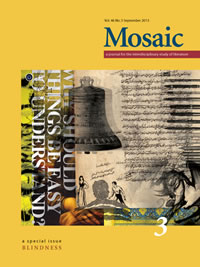Issue 46.3
Overview

Special Issue: Blindness
Published: September 2013
View the issue introduction or see the issue summary and contents below.
10 essays, totalling 224 pages
$24.95 CAD
This superb special issue includes colour images, drawings, and ten essays on seeing and blindness. The issue broaches such topics as blindness and intimacy; scotoma; sense substitution; aesthetic blindness; visualizing disability; empathy; animal’s eyes; and “the blind bard.”
Gone, MissingH. Peter Steeves Seeing and blindness are not true opposites, but rather constitute a complex whole that allows the world to appear. By means of the scotoma, this essay takes up the project of a phenomenological-aesthetic description of the role that blindness plays in seeing and, more specifically, in the seeing of paintings. | |
Blindness and Intimacy in Early Twentieth-Century LiteratureMaren Linett This essay traces an association between blindness and intimacy in J.M. Synge’s The Well of the Saints, Florence Barclay’s The Rosary, and D.H. Lawrence’s “The Blind Man,” suggesting that the association participates in an early twentieth-century devaluation of vision and stems from beliefs about knowledge and communication. | |
Where Blindness is Not (?) a Disability: Alison Sinclair’s Darkborn TrilogyDerek Newman-Stille Perhaps more than realism, fantasy provides an opportunity to examine how ideas of bodily normalcy dominate and restrict our society. Fantasy can explore the cultural understanding and construction of blindness as a disability. Although blindness is often constructed as a disability, Alison Sinclair creates a world in which blindness is normative. | |
Animal’s Eyes: Spectacular Invisibility and the Terms of Recognition in Indra Sinha’s Animal’s PeopleAndrew Mahlstedt Dominant narratives of poverty in the global south exacerbate the invisibility of the marginalized poor, blinding observers to all but a spectacle of abject destitution. Paying attention to narrative and the question of visibility in the context of recent globalization, this essay considers how Animal’s People represents disempowerment without disempowering. | |
Vicariates of the Eye: Blindness, Sense Substitution, and Writing Devices in the Nineteenth CenturyJan Eric Olsén This essay asks how teachers and pedagogues of the blind regarded the relation between blindness and sense substitution in the latter half of the nineteenth century. The essay provides an account of the concept of Sinnesvikariat and compares its inner sensorial implications with the adaptation of blindness to new, external forms of sense compensation. | |
Aesthetic Blindness: Symbolism, Realism, and RealityDavid Bolt As a representation of blindness, Maurice Maeterlinck’s The Blind is highly problematic and becomes more so if we fail to engage with its social implications. This essay teases out these issues, compares their representation with contemporaneous works of realism, and illustrates the play’s twenty-first-century relevance on the basis of visually impaired embodiment. | |
Blinding the Screen: Visualizing Disability in Le scaphandre et le papillonTess Jewell This essay examines how the first-person perspective employed in Julian Schnabel’s Le scaphandre et le papillon draws on previous cinematic traditions to configure blindness for a sighted audience. Engaging with common metaphors of disability, the essay explores whether this film’s cinematic representation of blindness opens new possibilities for conceptualizing visual impairment. | |
To the Side of the Day: Comparison without Comparison in Pynchon (and. . .)David Kelman This essay argues that comparative literature should not be theorized in terms of how comparison appears, but rather how it does not fully appear. By focusing on the (in)comparability of catastrophic events, Pynchon’s work suggests that comparison is “avisual,” since it takes place as the splitting apart of the day. | |
The Blind Bard, According to John Milton and His ContemporariesAngelica Duran This essay approaches Milton’s representation of the “blind bard” within the most personal literary mode of lyric (specifically, three sonnets) and through the figuration of blindness by his contemporary detractors in the service of suggesting how key terms of disability studies merge with literary elements, especially imagery and authorship. | |
‘Looking on darkness, which the blind do see’: Blindness, Empathy, and Feeling SeeingMark Paterson There is a critical concern with the underlying fascination by the sighted with what the blind “see.” The idea of empathic vision, or “feeling seeing,” reveals an allied inquisitiveness concerning what the blind feel, which this essay pursues through a series of authorial voices, persistent myths, and tropes. |